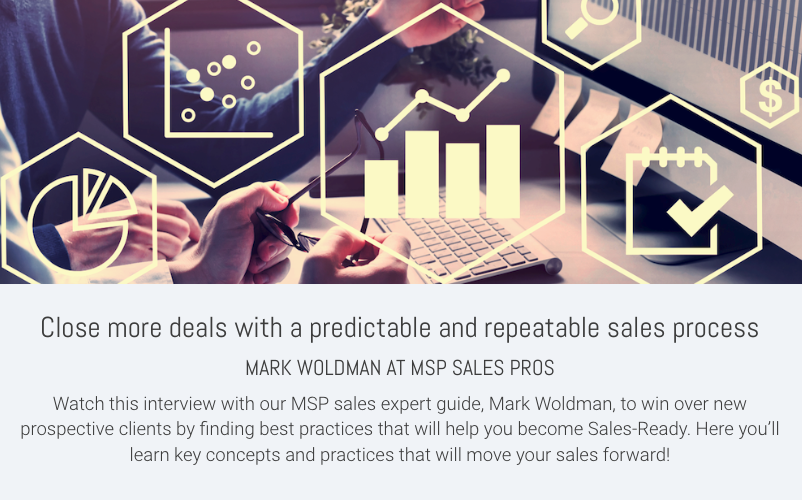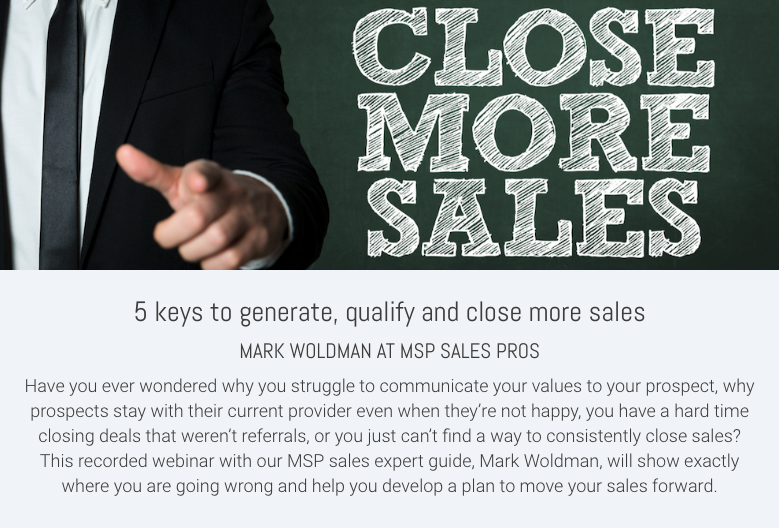
We think that one of the biggest reasons for this is the failure to separate different kinds of sales, and trying to use one strategy to sell everything offered.
In the days before cloud-based applications and storage, when clients had to maintain a lot more of their own IT infrastructure, when the inevitable problems arose there was a clear need for the MSP to be there - to use a bit of business-validated tech mumbo-jumbo, and the sales were natural. Because the client had obvious identifiable business pains, the choice of solution was straightforward.
These formerly ready solutions are now fragmented; company infrastructures are much less homogenous, so our model of one-size-fits-all IT service is no longer appropriate. In short, sales have become more complex.
So let's simplify the different IT sales roles and address them.
1. Upgrade T&M clients to MSP
Problem:
We have so much potential on existing T&M clients, but they have not upgraded to the MSP recurring contract yet - we’re leaving money on the table.
Challenge:
In order to import these existing clients we must demonstrate the business value of the MSP contract versus the T&M contract, but C level executives are rarely aware of the subtleties of this distinction and usually don’t put them high on their list of concerns.
Solution:
First of all, you have to identify who could benefit from the MSP contract at all. Companies of 15 or fewer users rarely suffer the complex problems an MSP contract solves. Give them the service of T&M, but don’t wait around hoping to see great potentials arising around them.
Second, you have to produce a business comparison between the T&M and the MSP contract in terms of delivered value, rather than on the features. To that end we developed the Managed Services Platform scoring system, which illustrates the difference in the competitiveness of IT with T&M compared to that with an MSP. This practical measure commonly generates T&M scores of 10-20 out of 100, and 45-55 for operations with managed service provider. This is their introduction to what we call the reframing process.

2. Acquire new clients
Problem:
There’s no getting around it...it’s real work to go through this process effectively.
Challenge:
This is a long process; you have to create leads, qualify them, and invest a lot of time with no guaranteed results. Long hours and multiple meetings go by without us and the client reaching alignment. We know there’s opportunities, but those who would benefit often seem unable to see them.
Solution:
After the first initial meeting, we usually use the IT competitiveness scoring we used in T&M. The role here though is different; it is is to evaluate the business context of their current IT setup. The scores show what they have going on at present. Our role is to assess what score they want to reach.
So if they score a 30, why is that? Do they lack the wherewithal to score higher, or is it a matter of choice? We can then use the different topics within the composite score to introduce possibilities. This shows them a clearly structured way to assess how they can enhance their IT’s impact on being a competitive company. Also, the benchmark score gives them a reference point for them to compare their performance to the industry.
Finally, with this approach, client acquisition could consume less of the upper level personnel's time as the process is standardized and proven in use.
3. UPsell third party productized services
Problem:
For some problems, we are tasked to find the solutions.
Challenge:
There are so many XaaS offering MSPs that could sell (virtualized desktops, BDR, DRP, etc.). Most of them are disrupting one or another current MSP service, so it is quite difficult to fit the portfolio. For example, Office 365 is now disrupting current Hosted Exchange solutions, and BDR solutions are disrupting our existing backup practices, and so on.
Solution:
This is product-based selling, which is very different from traditional service-based selling. Although the product is a service, there is a beginning; an end; and a package with features. These are not the flexible services we usually sell to customers.
That means that there are are certain problems and opportunities that can be dealt with by features you could put on the contract page. For instance, you could have a slide deck, and the problem is solved therein.
However, you have to determine if clients are interested in the features and then sell them, and because we’re talking about product selling, a different IT sales approach is required. Hire IT sales representatives for that and let them do the job...give them the quotas and products, and train them. Then you can sell those items since you’ve defined the problems have been through a minor discovery, and consulting will follow.
4. Complex Solution Selling
Problem:
Complex solutions like MSP services are hard and slow to sell, but are where the big money is. These are the complete cloud adoption and virtualization projects, ERP, CRM, and B2B E-commerce solutions we are always waiting for.
Challenge:
Selling complex solutions is a slow process. It involves third parties, and figuring out the needs of the client and evaluate the available solutions. In this case, it is very unlikely that we are operating without any competitors, and while our services are not always measured, our products are. So even when we’re great, they have their own priorities, and could choose another product.
Solution:
In most cases the party with the better understanding of the client is going to win, so again we highly recommend the IT competitiveness scoring tool, as it will distinguish us from our competitors. We can be more sure and precise about their priorities, problems and hidden opportunities. In this way we‘re able to develop a more appropriate and tailored solution, and highlight this in our presentation. Moreover, showing the business context around the IT solutions is always beneficial. It means we spell out the "why" of the solution, instead of the "what" and "how." The client will understand from their own point of view why they need those in their operation, sales, marketing, etc.
Conclusion
First, understand what you’re selling. Don’t use one method for all different types of sales, sell only one thing at a time, and don’t sell everything at once to a new client - you’ll likely mess up the flow of processes, and leave the client confused.
Second, use a business scoring tool to align your prospects and clients with their business perspectives. It’ll helps you close deals faster and with a better success rate.



